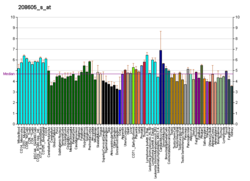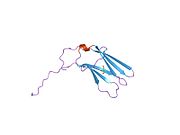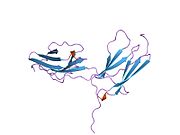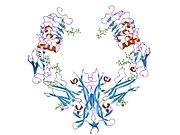| NTRK1 |
|---|
 |
| Available structures |
|---|
| PDB | Pretraga ortologa: PDBe RCSB |
|---|
| List of PDB id codes |
|---|
1HE7, 1SHC, 1WWA, 1WWW, 2IFG, 4AOJ, 4F0I, 4GT5, 4CRP, 4PMM, 4PMP, 4PMS, 4PMT, 4YNE, 4YPS |
|
|
| Identifikatori |
|---|
| Alijasi | NTRK1 |
|---|
| Spoljašnji ID | OMIM: 191315 MGI: 97383 HomoloGene: 1898 GeneCards: NTRK1 |
|---|
| Genska lokacija (miš) |
|---|
 | | Hr. | Chromosome 3 (mouse)[1] |
|---|
| | Band | 3 F1|3 38.62 cM | Start | 87,685,551 bp[1] |
|---|
| Kraj | 87,702,469 bp[1] |
|---|
|
| Obrazac RNK izražavanja |
|---|
 | | More reference expression data |
|
| Genska ontologija |
|---|
| Molecular function | • neurotrophin binding
• GPI-linked ephrin receptor activity
• neurotrophin receptor activity
• kinase activity
• ATP binding
• protein kinase activity
• kinase binding
• transferase activity
• protein homodimerization activity
• GO:0001948, GO:0016582 везивање за протеине плазме
• nucleotide binding
• nerve growth factor binding
• neurotrophin p75 receptor binding
• protein tyrosine kinase activity
• transmembrane receptor protein tyrosine kinase activity
• nerve growth factor receptor activity
|
|---|
| Cellular component | • цитоплазма
• Endozom
• мембрана
• late endosome membrane
• површина ћелије
• саставни део мембране
• late endosome
• early endosome membrane
• receptor complex
• ћелијска мембрана
• аксон
• тело нервне ћелије
• early endosome
• integral component of plasma membrane
• дендрит
• GO:0016023 cytoplasmic vesicle
• Golgi membrane
• endosome membrane
• GO:0009327 макромолекуларни комплекс
• recycling endosome
• recycling endosome membrane
|
|---|
| Biological process | • GO:1904089 негативно уређење неурона процеса апоптозе
• positive regulation of protein phosphorylation
• positive regulation of Ras protein signal transduction
• positive regulation of programmed cell death
• behavioral response to formalin induced pain
• detection of temperature stimulus involved in sensory perception of pain
• protein phosphorylation
• биолошки часовник
• positive regulation of ERK1 and ERK2 cascade
• B cell differentiation
• реакција на етанол
• инервација
• negative regulation of cell population proliferation
• реакција на никотин
• GO:0032320, GO:0032321, GO:0032855, GO:0043089, GO:0032854 positive regulation of GTPase activity
• positive regulation of synaptic transmission, glutamatergic
• response to nutrient levels
• учење или памћење
• protein autophosphorylation
• negative regulation of neuron death
• detection of mechanical stimulus involved in sensory perception of pain
• диференцијација
• neurotrophin TRK receptor signaling pathway
• Fosforilacija
• cellular response to nicotine
• olfactory nerve development
• одговор на електрични подстицај
• Sertoli cell development
• mechanoreceptor differentiation
• ментални развој
• positive regulation of angiogenesis
• positive regulation of NF-kappaB transcription factor activity
• response to axon injury
• sensory perception of pain
• response to radiation
• phosphatidylinositol-mediated signaling
• sympathetic nervous system development
• ephrin receptor signaling pathway
• cellular response to growth factor stimulus
• GO:0010260 биолошко старење
• response to hydrostatic pressure
• response to activity
• axon guidance
• multicellular organism development
• axonogenesis involved in innervation
• positive regulation of neuron projection development
• programmed cell death involved in cell development
• positive regulation of synapse assembly
• transmembrane receptor protein tyrosine kinase signaling pathway
• microtubule-based movement
• peptidyl-tyrosine phosphorylation
• peptidyl-tyrosine autophosphorylation
• nerve growth factor signaling pathway
• cellular response to nerve growth factor stimulus
• positive regulation of phosphatidylinositol 3-kinase signaling
• негативно регулисање апоптотичког процеса
• regulation of MAPK cascade
• positive regulation of MAPK cascade
• cellular response to amyloid-beta
|
|---|
| Sources:Amigo / QuickGO |
|
| Ortolozi |
|---|
| Vrste | Čovek | Miš |
|---|
| Entrez | | |
|---|
| Ensembl | | |
|---|
| UniProt | | |
|---|
| RefSeq (mRNA) | |
|---|
NM_002529
NM_001007792
NM_001012331 |
| |
|---|
| RefSeq (protein) | |
|---|
NP_001007793
NP_001012331
NP_002520 |
| |
|---|
| Location (UCSC) | n/a | Chr 3: 87.69 – 87.7 Mb |
|---|
| PubMed search | [2] | [3] |
|---|
| Wikidata |
| View/Edit Human | View/Edit Mouse |
|
Receptor nervnog faktora rasta visokog afiniteta (engl. High affinity nerve growth factor receptor; neurotrofni tirozinski kinazni receptor tipa 1, TRK1-transformišući tirozinski kinazni protein, Trk-A) protein je koji je kod ljudi kodiran NTRK1 genom.[4]
Ovaj gen kodira člana familije neurotrofnih tirozinskih kinaznih receptora (NTKR). Ova kinaza je za membranu vezani receptor koji, nakon neurotrofinskog vezivanje, fosforiliše sebe (autofosforilacija) i članove MAPK puta. Prisustvo ove kinaze dovodi do ćelijske diferencijacije i može da ima ulogu u specificiranju senzornih neuronskih podtipova. Mutacije ovog gena su vezane za kongenitalnu insenzitivnost na bol sa anhidrozom, samo povređivanje, mentalnu retardaciju i kancer. Alternativne transkriptne splajsne varijante ovog gena su poznate, ali su samo tri do sada okarakterisane.[5]
Interakcije
TrkA formira interakcije sa:
- Abl gene,[6][7]
- FRS2,[8]
- Grb2,[9][10]
- MATK,[11]
- NGFB,[12][13][14]
- PLCG1,[6][8][15][16]
- RICS,[17]
- SQSTM1,[18][19][20][21]
- SH2B1,[6][16]
- SH2B2,[16] and
- SHC1.[6][8][16][17][22]
Mali molekuli kao što su amitriptilin i derivat gamboginske kiseline aktiviraju TrkA. Amitriptilin aktivira TrkA i omogućava heterodimerizaciju TrkA i TrkB u odsustvu NGF. Do vezivanja amitriptilina za TrkA dolazi u leucinom bogatom regionu (LRR) ekstracelularnog domena receptora, koji je udaljen od NGF mesta vezivanje. Amitriptilin poseduje neurotrono dejstvo in-vitro i in-vivo (mišji model).[23] Gamboginski amid, derivat gamboginske kiseline, selektivno aktivira TrkA (a ne aktivira TrkB i TrkC) in-vitro i in-vivo putem interakcije sa citoplazmatičnim domenom u blizini membrane.[24]
Reference
- ^ а б в GRCm38: Ensembl release 89: ENSMUSG00000028072 - Ensembl, May 2017
- ^ „Human PubMed Reference:”. National Center for Biotechnology Information, U.S. National Library of Medicine.
- ^ „Mouse PubMed Reference:”. National Center for Biotechnology Information, U.S. National Library of Medicine.
- ^ Martin-Zanca D, Hughes SH, Barbacid M (1986). „A human oncogene formed by the fusion of truncated tropomyosin and protein tyrosine kinase sequences”. Nature. 319 (6056): 743—8. PMID 2869410. doi:10.1038/319743a0.
- ^ „Entrez Gene: NTRK1 neurotrophic tyrosine kinase, receptor, type 1”.
- ^ а б в г Koch A, Mancini A, Stefan M, Niedenthal R, Niemann H, Tamura T (2000). „Direct interaction of nerve growth factor receptor, TrkA, with non-receptor tyrosine kinase, c-Abl, through the activation loop”. FEBS Lett. 469 (1): 72—6. PMID 10708759. doi:10.1016/S0014-5793(00)01242-4.
- ^ Yano H, Cong F, Birge RB, Goff SP, Chao MV (2000). „Association of the Abl tyrosine kinase with the Trk nerve growth factor receptor”. J. Neurosci. Res. 59 (3): 356—64. PMID 10679771. doi:10.1002/(SICI)1097-4547(20000201)59:3<356::AID-JNR9>3.0.CO;2-G.
- ^ а б в Meakin SO, MacDonald JI, Gryz EA, Kubu CJ, Verdi JM (1999). „The signaling adapter FRS-2 competes with Shc for binding to the nerve growth factor receptor TrkA. A model for discriminating proliferation and differentiation”. J. Biol. Chem. 274 (14): 9861—70. PMID 10092678. doi:10.1074/jbc.274.14.9861.
- ^ Song C, Perides G, Liu YF (2002). „Expression of full-length polyglutamine-expanded Huntingtin disrupts growth factor receptor signaling in rat pheochromocytoma (PC12) cells”. J. Biol. Chem. 277 (8): 6703—7. PMID 11733534. doi:10.1074/jbc.M110338200.
- ^ MacDonald JI, Gryz EA, Kubu CJ, Verdi JM, Meakin SO (2000). „Direct binding of the signaling adapter protein Grb2 to the activation loop tyrosines on the nerve growth factor receptor tyrosine kinase, TrkA”. J. Biol. Chem. 275 (24): 18225—33. PMID 10748052. doi:10.1074/jbc.M001862200.
- ^ Yamashita H, Avraham S, Jiang S, Dikic I, Avraham H (1999). „The Csk homologous kinase associates with TrkA receptors and is involved in neurite outgrowth of PC12 cells”. J. Biol. Chem. 274 (21): 15059—65. PMID 10329710. doi:10.1074/jbc.274.21.15059.
- ^ Nykjaer A, Lee R, Teng KK, Jansen P, Madsen P, Nielsen MS, Jacobsen C, Kliemannel M, Schwarz E, Willnow TE, Hempstead BL, Petersen CM (2004). „Sortilin is essential for proNGF-induced neuronal cell death”. Nature. 427 (6977): 843—8. PMID 14985763. doi:10.1038/nature02319.
- ^ Lee R, Kermani P, Teng KK, Hempstead BL (2001). „Regulation of cell survival by secreted proneurotrophins”. Science. 294 (5548): 1945—8. PMID 11729324. doi:10.1126/science.1065057.
- ^ Wiesmann C, Ultsch MH, Bass SH, de Vos AM (1999). „Crystal structure of nerve growth factor in complex with the ligand-binding domain of the TrkA receptor”. Nature. 401 (6749): 184—8. PMID 10490030. doi:10.1038/43705.
- ^ Ohmichi M, Decker SJ, Pang L, Saltiel AR (1991). „Nerve growth factor binds to the 140 kd trk proto-oncogene product and stimulates its association with the src homology domain of phospholipase C gamma 1”. Biochem. Biophys. Res. Commun. 179 (1): 217—23. PMID 1715690. doi:10.1016/0006-291X(91)91357-I.
- ^ а б в г Qian X, Riccio A, Zhang Y, Ginty DD (1998). „Identification and characterization of novel substrates of Trk receptors in developing neurons”. Neuron. 21 (5): 1017—29. PMID 9856458. doi:10.1016/S0896-6273(00)80620-0.
- ^ а б Nakamura T, Komiya M, Sone K, Hirose E, Gotoh N, Morii H, Ohta Y, Mori N (2002). „Grit, a GTPase-activating protein for the Rho family, regulates neurite extension through association with the TrkA receptor and N-Shc and CrkL/Crk adapter molecules”. Mol. Cell. Biol. 22 (24): 8721—34. PMC 139861
 . PMID 12446789. doi:10.1128/MCB.22.24.8721-8734.2002.
. PMID 12446789. doi:10.1128/MCB.22.24.8721-8734.2002. - ^ Wooten MW, Seibenhener ML, Mamidipudi V, Diaz-Meco MT, Barker PA, Moscat J (2001). „The atypical protein kinase C-interacting protein p62 is a scaffold for NF-kappaB activation by nerve growth factor”. J. Biol. Chem. 276 (11): 7709—12. PMID 11244088. doi:10.1074/jbc.C000869200.
- ^ Geetha T, Wooten MW (2003). „Association of the atypical protein kinase C-interacting protein p62/ZIP with nerve growth factor receptor TrkA regulates receptor trafficking and Erk5 signaling”. J. Biol. Chem. 278 (7): 4730—9. PMID 12471037. doi:10.1074/jbc.M208468200.
- ^ Jadhav T, Geetha T, Jiang J, Wooten MW (2008). „Identification of a consensus site for TRAF6/p62 polyubiquitination”. Biochem. Biophys. Res. Commun. 371 (3): 521—4. PMC 2474794
 . PMID 18457658. doi:10.1016/j.bbrc.2008.04.138.
. PMID 18457658. doi:10.1016/j.bbrc.2008.04.138. - ^ Wooten MW, Geetha T, Babu JR, Seibenhener ML, Peng J, Cox N, Diaz-Meco MT, Moscat J (2008). „Essential role of sequestosome 1/p62 in regulating accumulation of Lys63-ubiquitinated proteins”. J. Biol. Chem. 283 (11): 6783—9. PMID 18174161. doi:10.1074/jbc.M709496200.
- ^ Borrello MG, Pelicci G, Arighi E, De Filippis L, Greco A, Bongarzone I, Rizzetti M, Pelicci PG, Pierotti MA (1994). „The oncogenic versions of the Ret and Trk tyrosine kinases bind Shc and Grb2 adaptor proteins”. Oncogene. 9 (6): 1661—8. PMID 8183561.
- ^ Jang SW, Liu X, Chan CB, Weinshenker D, Hall RA, Xiao G, Ye K (2009). „Amitriptyline is a TrkA and TrkB receptor agonist that promotes TrkA/TrkB heterodimerization and has potent neurotrophic activity.”. Chem Biol. 16 (6): 644—656. PMC 2844702
 . PMID 19549602. doi:10.1016/j.chembiol.2009.05.010.
. PMID 19549602. doi:10.1016/j.chembiol.2009.05.010. - ^ Jang SW, Okada M, Sayeed I, Xiao G, Stein D, Jin P, Ye K (2007). „Gambogic amide, a selective agonist for TrkA receptor that possesses robust neurotrophic activity, prevents neuronal cell death.”. Proc Natl Acad Sci U S A. 104 (41): 16329—16334. PMC 2042206
 . PMID 17911251. doi:10.1073/pnas.0706662104.
. PMID 17911251. doi:10.1073/pnas.0706662104.
Literatura
- Indo Y (2002). „Genetics of congenital insensitivity to pain with anhidrosis (CIPA) or hereditary sensory and autonomic neuropathy type IV. Clinical, biological and molecular aspects of mutations in TRKA(NTRK1) gene encoding the receptor tyrosine kinase for nerve growth factor.”. Clin. Auton. Res. 12 (Suppl 1): I20—32. PMID 12102460. doi:10.1007/s102860200016.
- Micera A, Lambiase A, Stampachiacchiere B, Bonini S, Bonini S, Levi-Schaffer F (2007). „Nerve growth factor and tissue repair remodeling: trkA(NGFR) and p75(NTR), two receptors one fate.”. Cytokine Growth Factor Rev. 18 (3–4): 245—56. PMID 17531524. doi:10.1016/j.cytogfr.2007.04.004.
Spoljašnje veze
- GeneReviews/NCBI/NIH/UW entry on Hereditary Sensory and Autonomic Neuropathy IV
-
1he7: Ljudski receptor nervnog faktora rasta TRKA -
1wwa: NGF vezujući domen ljudskog TRKA receptora -
1www: NGF u kompleksu sa domenom 5 TRKA receptora -
2ifg: Struktura ekstracelularnog segmenta ljudskog TRKA u kompleksu sa nervnim faktorom rasta |
|
|---|
|
|---|
| EGF receptorska familija | |
|---|
| Insulin receptor familija | |
|---|
| PDGF receptor familija | CSF1R • FLT3 • KIT • PDGFR (PDGFRA, PDGFRB) |
|---|
| FGF receptor familija | FGFR1 • FGFR2 • FGFR3 • FGFR4 |
|---|
| VEGF receptor familija | VEGFR1 • VEGFR2 • VEGFR3 • VEGFR4 |
|---|
| HGF receptor familija | |
|---|
| Trk receptor familija | |
|---|
| EPH receptor familija | EPHA1 • EPHA2 • EPHA3 • EPHA4 • EPHA5 • EPHA6 • EPHA7 • EPHA8 • EPHB1 • EPHB2 • EPHB3 • EPHB4 • EPHB5 • EPHB6 • EPHX |
|---|
| LTK receptor familija | LTK • ALK |
|---|
| TIE receptor familija | TIE • TEK |
|---|
| ROR receptor familija | ROR1 • ROR2 |
|---|
| DDR receptor familija | |
|---|
| PTK7 receptor familija | |
|---|
| RYK receptor familija | RYK |
|---|
| MuSK receptor familija | |
|---|
| ROS receptor familija | ROS1 |
|---|
| AATYK receptor familija | AATYK • AATYK2 • AATYK3 |
|---|
| AXL receptor familija | AXL • MER • TYRO3 |
|---|
| RET receptor familija | RET |
|---|
| nekategorisani | STYK1 |
|---|
|
|
|
|---|
| ABL familija | ABL1 • ARG |
|---|
| ACK familija | ACK1 • TNK1 |
|---|
| CSK familija | CSK • MATK |
|---|
| FAK familija | FAK • PYK2 |
|---|
| FES familija | FES • FER |
|---|
| FRK familija | FRK • BRK • SRMS |
|---|
| JAK familija | JAK1 • JAK2 • JAK3 • TYK2 |
|---|
| SRC-A familija | SRC • FGR • FYN • YES1 |
|---|
| SRC-B familija | BLK • HCK • LCK • LYN |
|---|
| TEC familija | TEC • BMX • BTK • ITK • TXK |
|---|
| SYK familija | SYK • ZAP70 |
|---|
|
|
B enzm: 1.1/2/3/4/5/6/7/8/10/11/13/14/15-18, 2.1/2/3/4/5/6/7/8, 2.7.10, 2.7.11-12, 3.1/2/3/4/5/6/7, 3.1.3.48, 3.4.21/22/23/24, 4.1/2/3/4/5/6, 5.1/2/3/4/99, 6.1-3/4/5-6 |
|
|---|
| Nervni faktori rasta | niski afinitet/p75 – visok afinitet Trk (TrkA, TrkB, TrkC) – Cilijarni neurotrofni faktor |
|---|
| Somatomedin | |
|---|
| CSF | |
|---|
| TGF put | TGF-beta (1, 2) – Aktivin (1, 2) – Bone morfogenetski protein (1, 2) |
|---|
| Drugi | |
|---|
vidi isto Faktori rasta |

 . PMID 12446789. doi:10.1128/MCB.22.24.8721-8734.2002.
. PMID 12446789. doi:10.1128/MCB.22.24.8721-8734.2002.  . PMID 18457658. doi:10.1016/j.bbrc.2008.04.138.
. PMID 18457658. doi:10.1016/j.bbrc.2008.04.138.  . PMID 19549602. doi:10.1016/j.chembiol.2009.05.010.
. PMID 19549602. doi:10.1016/j.chembiol.2009.05.010.  . PMID 17911251. doi:10.1073/pnas.0706662104.
. PMID 17911251. doi:10.1073/pnas.0706662104.  1he7: Ljudski receptor nervnog faktora rasta TRKA
1he7: Ljudski receptor nervnog faktora rasta TRKA 1wwa: NGF vezujući domen ljudskog TRKA receptora
1wwa: NGF vezujući domen ljudskog TRKA receptora 1www: NGF u kompleksu sa domenom 5 TRKA receptora
1www: NGF u kompleksu sa domenom 5 TRKA receptora 2ifg: Struktura ekstracelularnog segmenta ljudskog TRKA u kompleksu sa nervnim faktorom rasta
2ifg: Struktura ekstracelularnog segmenta ljudskog TRKA u kompleksu sa nervnim faktorom rasta

















